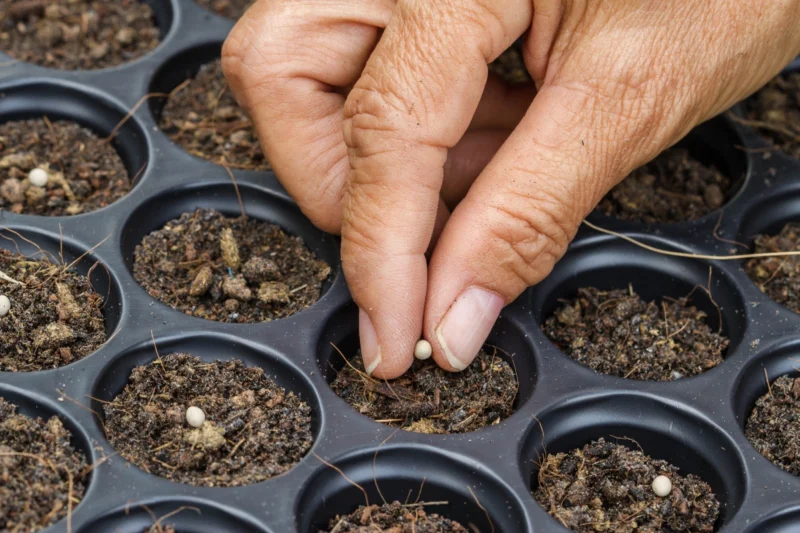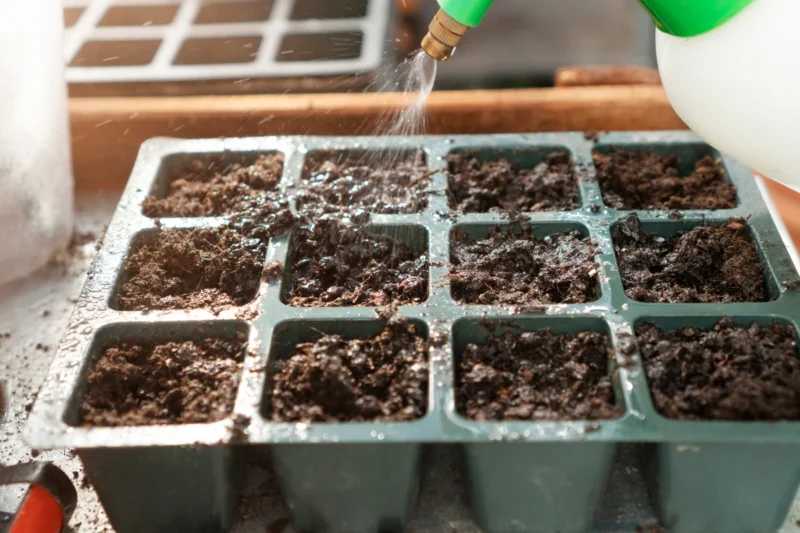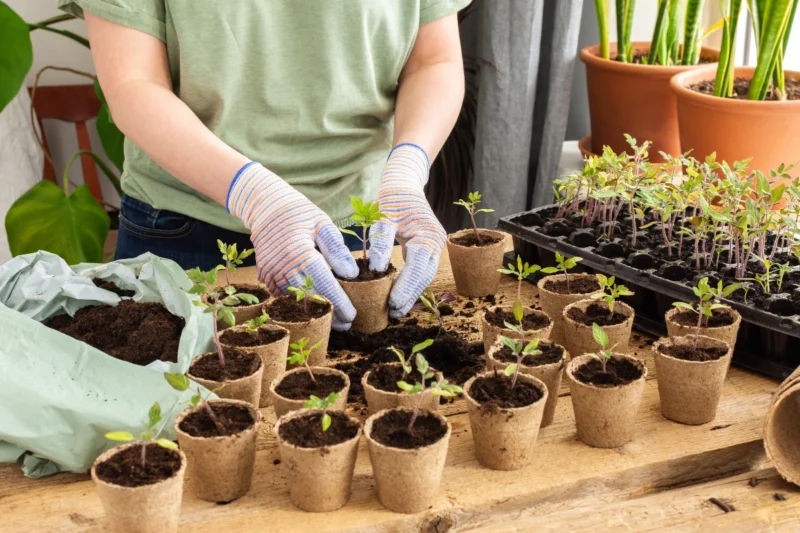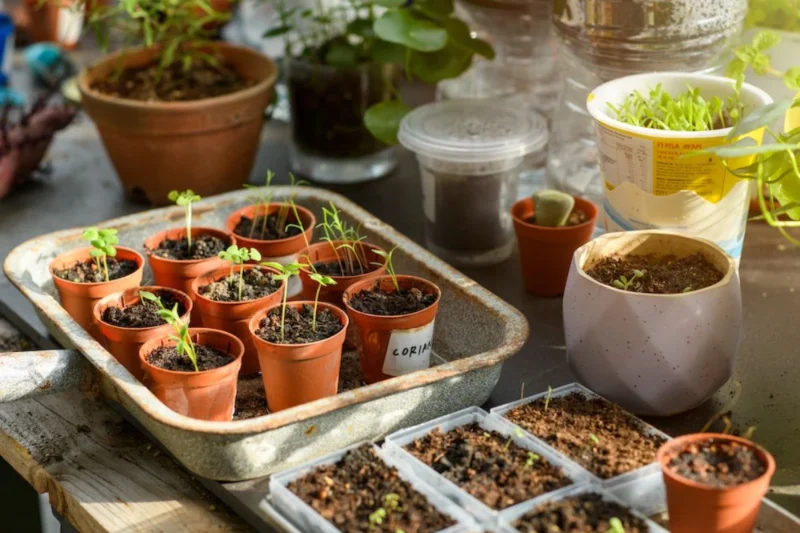Seed Tips
Starting Flower Seeds Indoors: How and When to Start Seeds
Timing is everything when starting flower seeds indoors! Sow too early, and your seedlings might outgrow their pots before it’s warm enough to plant them outside. Sow too late, and they may not have enough time to mature and bloom during the season. To help you get it just right, we’ll share expert tips and a handy seed-starting chart so you’ll know exactly how many weeks before your last spring frost to start your seeds indoors. Let’s get growing!
Why Start Flower Seeds Indoors?
Starting flower seeds indoors gives your garden a head start, leading to earlier blooms and a longer flowering season. For many flowers—especially those that require a longer growing period—this step is essential.
Some flowers, like petunias, snapdragons, and impatiens, need warm soil to germinate and won’t thrive if sown directly outdoors too early in the season. In cooler regions, such as the Northeast or Midwest, there may not be enough warm days for these flowers to mature and bloom in time. By starting seeds indoors, you gain several weeks of valuable growing time, ensuring your flowers reach full bloom when you want them to.
In warmer climates, starting flower seeds indoors allows you to get an extra round of blooms before the intense summer heat slows growth. This is especially helpful for cool-season flowers like pansies and sweet peas, which thrive in milder temperatures.

If you don’t start seeds yourself, your main option is buying flower transplants from a nursery or garden center. While some store-bought plants are healthy, others may be weak, root-bound, or treated with chemicals that affect their growth. Growing your flowers from seed gives you full control over their health and care from day one.
Here’s why starting from seed is a great choice:
More Variety: Garden centers offer a limited selection of flowers, but when you start from seed, you can grow unique or rare varieties that you won’t find in stores.
Healthier Plants: Homegrown seedlings tend to be stronger because you can provide them with the ideal conditions for growth, ensuring they are well-rooted and resilient when transplanted.
Organic and Chemical-Free: By starting your own seeds, you know exactly how they’ve been nurtured—without unnecessary pesticides or synthetic fertilizers.
Cost-Effective: Seeds are much cheaper than buying fully grown plants. A single seed packet can produce dozens of flowers for the price of just one nursery plant.
When to Start Flower Seeds Indoors
A good rule of thumb is to start flower seeds indoors about 6 weeks before your last expected frost date. This gives your seedlings enough time to grow strong before they are transplanted outdoors.
If you’re unsure of your last frost date, you can check a local gardening calendar or use an online frost date calculator based on your location.
Tip: If spring is colder than usual, it’s better to wait a little longer rather than start too early. Seeds need the right temperature to germinate, and planting too soon may result in weak seedlings or poor growth. Patience pays off when it comes to a thriving flower garden!
Which Flower Seeds to Start Indoors
Not all flowers need to be started indoors, but many benefit from an early start—especially those that take longer to germinate or require warm conditions to grow strong. The decision depends on the flower type, your climate, and your personal gardening preferences.

Here’s a general guide to help you decide:
Best Flowers to Start Indoors
Slow-growing flowers: Flowers that take a long time to mature, such as lavender, snapdragons, and delphiniums, should be started indoors to ensure they have enough time to bloom.
Heat-loving flowers: Petunias, impatiens, begonias, and marigolds prefer warm temperatures and benefit from indoor germination before being transplanted outside.
Delicate flowers: Flowers like coleus and geraniums have fragile seeds that need controlled indoor conditions for successful germination.
Flowers Best Started Directly Outdoors
Fast-growing annuals: Some flowers, like sunflowers, poppies, zinnias, and cosmos, grow quickly and thrive when sown directly into garden soil.
Root-sensitive plants: Flowers with delicate root systems, such as larkspur and sweet peas, don’t transplant well and prefer to start outdoors.
Cold-tolerant flowers: Alyssum and pansies can handle cooler temperatures, making direct outdoor sowing a great option.
Tip: If you’re unsure, check the seed packet! It often provides guidance on whether to start indoors or sow directly outdoors.
How to Start Flower Seeds Indoors: 3 Simple Steps
Starting flower seeds indoors is easier than you think! All you need is a good potting mix, proper containers, and a strong light source (more on lighting later). Follow these three simple steps to give your flowers the best start.

1. Choose the Right Potting Mix
The right soil mix is crucial for healthy seedling growth. Here’s what to keep in mind:
Use a light, well-draining mix – An all-purpose potting mix works well, but if it contains large wood chunks or rocks, sift it before using. Fine soil allows delicate roots to spread easily.
For small or delicate seeds, consider using a seed-starting mix. These are specially designed for germination and are lightweight, airy, and low in nutrients—which is ideal because seeds already contain the nutrients they need to sprout.
Avoid peat-based mixes – Peat is not the most sustainable option. Instead, choose coconut coir, a renewable and eco-friendly alternative that retains moisture well without becoming too compact.
Do NOT use garden soil – Outdoor soil is often too heavy for seedlings and may harbor pests or diseases that can hinder growth.
2. Choosing a Container
When starting flower seeds indoors, choosing the right container can make a big difference in growth and transplant success. You can use pots, plug trays, or even recycled containers, each with its own advantages.
Sowing in Pots
Using a single large pot to germinate multiple seeds is a space-efficient method, especially for tiny seeds like poppies, lobelia, or alyssum that can be difficult to handle individually. Once the seedlings sprout, they can be carefully transplanted into individual pots. This method works well for flowers that are easy to move, such as marigolds or pansies.
Using Plug Trays
Plug trays have individual compartments (or “cells”) for each seed, minimizing root disturbance when transplanting. This method works best for flowers like zinnias, petunias, and snapdragons, which grow well when kept separate from the start.
Each plug usually holds two seeds—if both germinate, thin out the weaker seedling.
Small plug trays work well for fast-growing flowers that will be transplanted outdoors within a few weeks.
Larger plug trays are ideal for flowers that take longer to develop, like geraniums or salvias.
Repurposing Recycled Containers
You don’t need fancy seed trays—yogurt cups, sour cream containers, or even plastic muffin trays can be turned into seed-starting containers! Just clean them well and poke drainage holes at the bottom. These containers work best for one or two seedlings at a time and will need to be transplanted once the plants grow bigger.
For an eco-friendly option, consider biodegradable fiber pots, which can be planted directly into the soil when it’s time to transplant. This is especially helpful for flowers like sunflowers and nasturtiums, which dislike root disturbance.
Pro Tip: Choose a container that provides good drainage and enough space for the roots to develop before transplanting.
3. Sowing in the Pot

Preparing Your Pot or Plug Tray
Fill your container to the brim with a light, well-draining potting mix.
Tamp it down gently but firmly. Seedlings prefer a solid base of soil, so don’t be afraid to press it in.
Top up with a bit more mix, then brush off any excess to create an even surface.
Planting Your Seeds
Use your finger, a pencil eraser, or a dibber (a small seed-sowing tool) to create planting holes. The depth should match the recommendation on the seed packet.
For tiny seeds (like poppies or snapdragons), simply sprinkle them on top and gently press them into the mix—many of these seeds need light to germinate and should not be buried deeply.
For larger seeds (like sunflowers or nasturtiums), plant them individually into deeper holes to give them space to sprout.
Choose the biggest, healthiest seeds from the packet for the best germination success.
Pro Tip: Some flower seeds, like petunias and begonias, are extremely tiny. If handling them is tricky, try mixing them with a little dry sand to help distribute them evenly.
Covering and Labeling
Once seeds are planted, cover them lightly with potting mix based on their depth requirements.
Label your trays or pots! It’s easy to forget which flowers you’ve planted, especially when seedlings look similar. Mark each container with the flower variety and sowing date to keep track.
Watering Your Seeds
Use a watering can with a fine sprinkling rose, a clean turkey baster, or a gentle mist sprayer to moisten the soil.
Be careful! A strong pour from a pitcher may wash away tiny seeds. Mist sprayers are gentle but may take time to fully saturate the mix.
Water thoroughly at the start—this wakes up the seeds and kickstarts germination. If using a well-draining mix, you won’t have to worry about overwatering at this stage.

Tips to Speed Up Germination
Here are some proven tips to help speed up germination and improve your success rate!
1. Maintain the Right Temperature
Most flower seeds germinate best between 65-75°F (18-24°C).
Use a seedling heat mat to provide consistent warmth, especially for heat-loving flowers like petunias, marigolds, and impatiens.
Keep your seeds in a warm, draft-free location—avoid placing them near cold windowsills or vents.
2. Pre-Soak or Stratify Tough Seeds
Some flower seeds have hard outer shells and benefit from pre-treatment:
Pre-soaking – Place seeds like morning glories or sweet peas in warm water for 6-12 hours before planting to soften their coat.
Cold stratification – Seeds of perennials like lavender, echinacea, or delphiniums may need a chilling period to break dormancy. Store them in a moist paper towel inside a plastic bag in the fridge for 1-4 weeks before sowing.
3. Keep the Soil Moist (But Not Too Wet!)
Use a fine mist sprayer or gentle watering can to keep the soil damp, not soggy.
Cover seed trays with a humidity dome or plastic wrap to trap moisture and create a greenhouse effect—just remove it once seedlings sprout to prevent mold.
Bottom watering (placing trays in a shallow water dish to soak up moisture) can help avoid disturbing tiny seeds.
4. Provide Light for Light-Sensitive Seeds
Some flower seeds, like petunias, snapdragons, and begonias, need light to germinate. Simply press them lightly onto the soil surface instead of burying them.
If growing in a dim area, use grow lights for 12-16 hours a day to encourage strong, even growth.
5. Give Seeds a Little Airflow
Proper airflow prevents mold and damping-off disease. Use a small fan on low speed near your seedlings for gentle air circulation.
Before transplanting your tender flower seedlings into the garden, they need to be gradually introduced to outdoor conditions. This process, called “hardening off,” helps seedlings adjust to sun, wind, and fluctuating temperatures, preventing transplant shock.
Indoor-grown seedlings are used to stable temperatures, indirect light, and controlled moisture. Suddenly moving them outside can stress the plants, causing wilting, leaf burn, or stunted growth. Hardening off strengthens seedlings so they can thrive outdoors.

Read more: How to harden off your seedlings
Final Thoughts
Starting flower seeds indoors is a rewarding and cost-effective way to grow a stunning, colorful garden. With the right soil, containers, watering, and hardening-off process, your seedlings will be strong, healthy, and ready to thrive outdoors.
Pro Tips for Success
Read the Seed Packet – Each flower variety has different needs for light, temperature, and planting depth. Follow the instructions for the best results!
Don’t Rush Transplanting – Wait until all danger of frost has passed before moving seedlings outdoors, especially for tender flowers like zinnias, marigolds, and petunias.
Thin Out Weak Seedlings – If multiple seeds sprout in one cell or pot, remove the weaker ones to allow the strongest plant to flourish.
Use a Grow Light if Needed – If you don’t have a sunny window, use a grow light for 12-16 hours a day to prevent seedlings from becoming leggy.
Be Patient – Some flowers, like lavender and delphiniums, take longer to germinate. Keep the soil moist and warm, and don’t give up too soon!
Keep Notes – Track which flowers germinate best, how long they take to sprout, and which methods work well for your garden. This will help improve your process each season!
Read more:Seed Tips: A Guide to Choosing and Caring for Quality Seeds
With a little care and attention, you’ll soon have beautiful, homegrown flowers that bring life and color to your garden. Happy planting!

